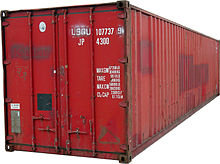
An intermodal container is a large standardized shipping container, designed and built for intermodal freight transport, meaning these containers can be used across different modes of transport – from ship to rail to truck – without unloading and reloading their cargo.
Intermodal containers exist in many types and a number of standardized sizes, but ninety percent of the global container fleet are so-called "dry freight" or "general purpose" containers,
Just like cardboard boxes and pallets, these containers are a means to bundle cargo and goods into larger, unitized loads, that can be easily handled, moved, and stacked, and that will pack tightly in a ship or yard. Intermodal containers share a number of key construction features to withstand the stresses of intermodal shipping, to facilitate their handling and to allow stacking, as well as being identifiable through their individual, unique ISO 6346 reporting mark.
In 2012 there were about 20.5 million intermodal containers in the world of varying types to suit different cargoes. The predominant alternative methods of transport carry bulk cargo – whether gaseous, liquid or solid – e.g. by bulk carrier or tank ship, tank car or truck. For air freight, the more light-weight IATA-defined unit load device is used.